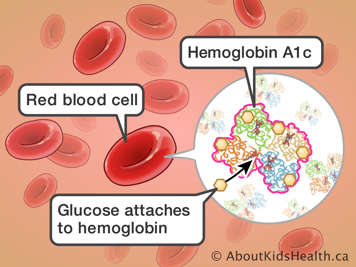Your child will need a hemoglobin A1c test after three months. This section will help you understand why it's being done and what to expect.

What is a hemoglobin A1c test?
The hemoglobin A1c test (also called the A1c test) is a measure of the average blood glucose (sugar) level over the previous three months. It can tell you whether your child’s overall blood sugar control is good, even though you might not notice daily changes.
What is hemoglobin?
Hemoglobin is a protein molecule inside red blood cells. This cell carries oxygen from the lungs to the rest of the body. Some sugar clings to hemoglobin in everyone, whether or not they have diabetes. It stays there for the lifespan of the red blood cell, which is about three to four months. The amount of sugar that sticks to the hemoglobin reflects the average blood sugar level during that period. It can be measured in a laboratory using the HbA1c test.
The A1c test shows the level of blood sugar control over the previous few months: When the average blood sugar level has been high, the A1c result will be high. The level of A1c achieved over time is the best way we can predict the risk of long-term diabetes-related complications, such as eye, kidney, or nerve damage.
A1c can be measured at any time of day by a blood test. There are different methods for measuring A1c. Some give immediate results; others take a day or longer.